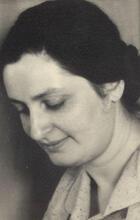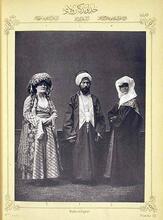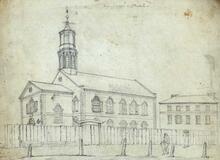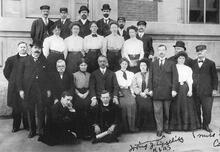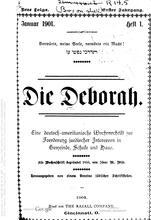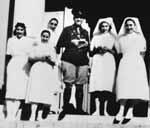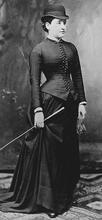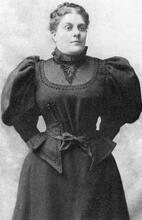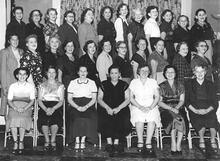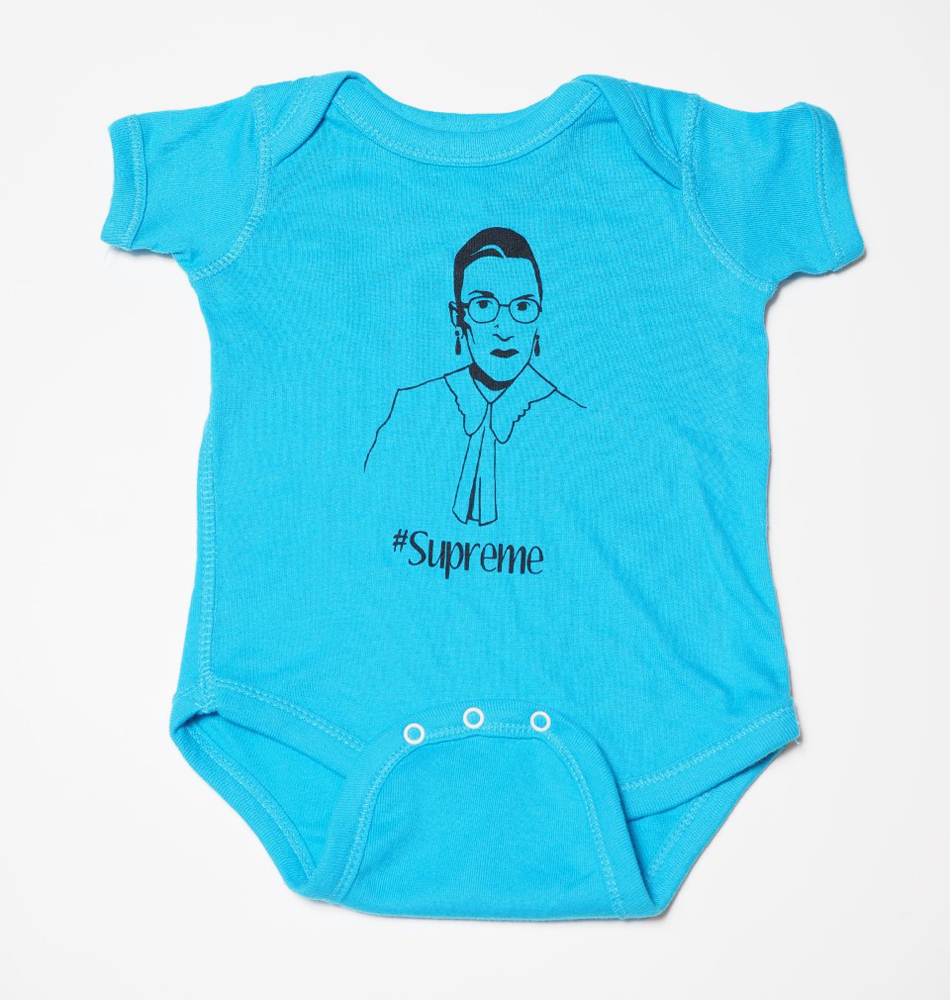Suburbanization in the United States
Jews migrated in large numbers to newly constructed suburbs after World War II and the end of restrictive covenants that had excluded them. During the day, suburbs were largely female spaces where married Jewish women cared for their children and private homes, while volunteering for Jewish and civic activities. Jewish daughters raised in suburbs enjoyed middle-class comforts but also experienced pressures to conform to American gentile ideals of beauty. New Jewish rituals like bat mitzvah took hold in suburbs in Conservative synagogues and Jewish girls received educational opportunities equal to Jewish boys.
Suburbanization in the Late Nineteenth and Early Twentieth Centuries
Few Jews participated in the first wave of suburbanization, the construction of streetcar suburbs at the end of the nineteenth century in such cities as Boston, Philadelphia, and Chicago. These new suburbs, Brookline in Massachusetts, the Main Line in Pennsylvania, and the North Shore in Illinois, did not offer homes to Jews. Class stratification characterized suburban districts, unlike the close proximity of rich, middle class, and poor in large cities. A newly created suburban utopia allowed residents to choose their neighbors, and few suburbanites wanted to live next door to Jews. Many employed either individual residential covenants or corporate regulations of planned communities to prevent Jews from purchasing or renting homes.
Nonetheless, the children and grandchildren of Jewish immigrants embraced the American dream of home ownership and suburban living in the twentieth century. Like other Americans, Jews desired the cleanliness, quiet, and security that came from living in a white, upper-middle-class community. Thus, Jewish developers built a handful of Jewish suburbs during the second wave of suburbanization prior to World War II. Most American cities with large Jewish populations included at least one such suburban district, usually within the city’s boundaries. Observers considered these neighborhoods Jewish because of the visible presence of Jews (often as much as thirty percent of the population) and Jewish institutions, including large, modern synagogues.
The Post-War Period
Most Jews, however, did not opt for suburban living until the mass-produced suburbs of the 1950s and 1960s brought home ownership within the reach of millions of middle-class Americans. In 1948, the Supreme Court declared restrictive residential covenants to be illegal, invigorating efforts of such organizations as the American Jewish Congress to eliminate antisemitic discrimination in housing. Gradually, many suburbs opened to Jews (especially those constructed by Jewish developers), allowing them to access generous GI benefits. Since they were integrated into military units as white and not segregated as were African Americans, Jews received low-cost mortgage benefits like other white servicemen. Unlike their predecessors, these new suburbs were designed for automobiles and were built beyond a city’s boundaries. Like their predecessors, they were residential enclaves, stratified by class and race (almost all excluded African Americans), where women and children spent their days while men worked in the nearby cities.
Jewish women responded in diverse ways to suburban living. When the occasional well-to-do immigrant families first moved to Jewish suburbs, the women were initially disoriented by the isolation of the individual homes and lack of public culture. However, many women appreciated freedom from paid employment and the opportunity to devote themselves to child rearing and housekeeping. Many extended their understanding of maternal responsibilities to include a larger, Jewish public sphere. Jewish women’s organizations, from the National Council of Jewish Women to Hadassah to synagogue sisterhoods, successfully recruited suburbanites.
Jewish women also participated in American civic and cultural organizations. But they rarely socialized with their gentile neighbors, despite socioeconomic similarities. The Jewish suburb, sometimes called a “gilded ghetto”—a term evoking the wealthy yet exclusively Jewish character of these enclaves—supported many Jewish social and leisure-time organizations, including country clubs. Jews pursued suburban leisure and recreation activities almost exclusively with other Jews, behavior that came to be seen as typically Jewish. Ethnic sociability replaced religious or political affiliation as a bond uniting Jews.
Jewish girls growing up in the suburbs sometimes found them stifling. Despite the good secular education they received in public schools, they faced a narrow choice of gender roles. Most were expected to marry and raise children without even a short interlude of paid employment. Few acquired more than a minimal Sunday school Jewish education, although their parents often provided them with many material comforts.
In the postwar period, stereotypes and popular culture often ridiculed pampered suburban Jewish daughters like the fictitious Brenda Patimkin in Philip Roth’s novel, Goodbye, Columbus. Despite her elite Radcliffe education, Brenda is shallow and immature, more concerned with getting her nose fixed to conform to gentile standards of beauty than with any aspects of intellectual or political life. As a minority growing up in a world shaped by middle-class, American values, suburban Jewish daughters often struggled to attain a sense of Jewish self-esteem in the face of widespread negative attitudes toward Jews. A few rebelled by pursuing political activism to achieve social justice or by adopting a bohemian life-style that rejected the conformity and materialistic values of suburbia.
Diversification of Jewish Suburbs
When the Jewish middle class moved to the suburbs en masse, different types of Jewish suburbs developed. By the 1970s and 1980s, Syrian Jews and Iranian Jews each had their own suburban enclaves, as did Iraqi Jews. The Baltimore suburb of Pikesville became a majority Jewish community with strong Ashkenazi Orthodox educational and religious institutions. Great Neck, New York, gained a reputation for political liberalism, as did Newton, Massachusetts. Jews also began settling in integrated suburbs, where they remained a small minority—under ten percent of the population. Around New York City, home to roughly forty percent of the American Jewish population prior to World War II, Jews settled in suburbs in Westchester county and northern New Jersey, and especially on Long Island.
Suburbanization and postwar affluence stimulated an extensive period of synagogue building. Conservative Judaism, especially, benefited from this growth in congregations. Jewish girls, in turn, benefited from the expanded educational opportunities provided by Conservatism, including adoption of the bat mitzvah marking a Jewish girl’s coming of age. Nevertheless, materialism and concern for gentile standards of beauty persisted even as social barriers between Jews and gentiles gradually diminished. Rebellious Jewish daughters often identified these characteristics of suburban life not as typically American middle class, but as essentially Jewish.
In the twenty-first century, Orthodox Jews—both modern Orthodox and Hasidim—also suburbanized. A Hasidic sect, such as the Satmar, found suburbanization to be a means of seclusion and a way to create a cohesive, encompassing environment. In addition to supervising the household and often large families, women usually earned a livelihood, helping their husbands to pursue the ideal of religious study.
The Mixed Blessings of Suburbs
Postwar middle-class Jewish women raising their families in the suburbs turned to a wide range of volunteer activities to take them out of their private homes and enhance their lives. These activities included political action, usually on a local scale. Jewish women brought liberalism to the suburbs, supporting taxation to build strong public schools, the antinuclear peace movement, and laws guaranteeing civil rights for minorities, including open housing legislation. They also advocated specifically Jewish concerns, championing the new State of Israel and efforts to allow emigration for Soviet Jewry. Many suburban Jewish women supported the feminist movement’s political agenda, especially equal rights for women and legalization of abortion, and encouraged their daughters’ fight for equality in public schools, including access to team sports. After their children left home, some Jewish mothers decided to look for jobs or attend college or professional school.
By 1970 suburbs became the popular residential choice of most Americans, overshadowing cities. No longer exclusively residential, suburbs housed industry and commerce as well as businesses. Despite their increasing diversity, they still lacked the population density, poverty, and public culture of urban centers.
Suburbs have offered Jewish women mixed blessings. On the positive side are material comforts, good schools, and a safe environment in which to raise a family. On the negative side are standards of femininity and beauty that weaken Jewish self-esteem, narrow gender roles, materialistic values, and reduced access to Jewish, intellectual, and cultural pursuits.
Baldassare, Mark. Trouble in Paradise: The Suburban Transformation of America. New York: Columbia University Press, 1986.
Baum, Charlotte, Paula Hyman, and Sonya Michel. The Jewish Woman in America. New York: Doubleday, 1976.
Binzen, Peter. “A Place to Live.” In Philadelphia Jewish Life 1940–1985, edited by Murray Friedman. Seth Press, 1986.
Ebner, Michael. Creating Chicago’s North Shore. Chicago: University of Chicago Press, 1988.
Fishman, Robert. Bourgeois Utopias: The Rise and Fall of Suburbia. New York: Basic Books, 1987.
Gans, Herbert. “Park Forest: Birth of a Jewish Community.” Commentary 11 (April 1951): 330–339.
Gans, Herbert. “Progress of a Suburban Jewish Community.” Commentary 23 (February 1957): 113–122.
Goldstein, Judith S. Inventing Great Neck: Jewish Identity and the American Dream. New Brunswick, NJ: Rutgers University Press, 2006.
Jackson, Kenneth. Crabgrass Frontier: The Suburbanization of the United States. New York: Oxford University Press, 1985.
Kramer, Judith, and Seymour Leventman. Children of the Gilded Ghetto. New Haven: Yale University Press, 1961.
Kranson, Rachel. Ambivalent Embrace: Jewish Upward Mobility in Postwar America. Chapel Hill, NC: University of North Carolina Press, 2017.
Phillips, Bruce A. “Not Quite White: The Emergence of Jewish Ethnoburbs in Los Angeles, 1920-2010,” American Jewish History 100:1 (January 2016): 73-104.
Prell, Riv-Ellen. “Communities of Choice and Memory: Conservative Synagogues in the Late Twentieth Century.” In Jews in the Center: Conservative Synagogues and Their Members, edited by Jack Wertheimer. New Brunswick, NJ: Rutgers University Press, 2000.
Shargel, Baila R. The Jews of Westchester: A Social History. Fleischmanns, New York: Purple Mountain Press, 1994.
Sklare, Marshall, and Joseph Greenblum. Jewish Identity on the Suburban Frontier: A Study of Group Survival in the Open Society. Chicago: University of Chicago Press, 1979.
Warner, Sam Bass, Jr. Streetcar Suburbs: The Process of Growth in Boston 1870–1900. Cambridge, MA: Harvard University Press, 1969.

